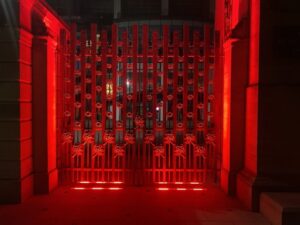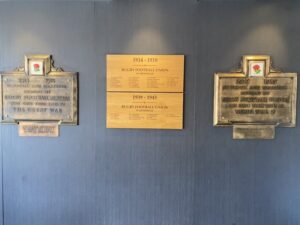Remembrance weekend: Twickenham Stadium’s war memorials
The RFU commemorates the war dead on Remembrance weekend each year, through both acts of remembrance and permanent memorials.
This is held as a foundation of English rugby by the RFU, with memorials to the fallen seen across their home at Twickenham Stadium.
The somewhat recent centenary of the First World War has, naturally, lent itself to be the primary focus of this commemoration. Within Twickenham Stadium, there are four permanent war memorials.
The Rose and Poppy Gates

The most notable of these, and only one freely open to the public, is the Rose and Poppy Memorial Gates. Created by sculptor Harry Gray, the gates were unveiled in 2016, before that year’s Army Navy Match.
The Rose and Poppy Gates mark the players’ entrance to the stadium, being a focal point each matchday.
Featuring 15 roses modelled on those worn by the 1914 English grand slam-winning side, the roses transform into memorial poppies as the gates rise.
The flowers were sculpted from spent artillery casings recovered from Great War battlefields. Markings from the shells are still visible.
Steeped in symbolism, the gates were designed to be as tall as a war-time trench. They are intended to offer a sense of perspective to fans without distracting from the matchday experience.
Ronnie Poulton
Pitch-side at Twickenham is a memorial to Ronald ‘Ronnie’ Poulton –England’s captain at the outbreak of the First World War. This memorial features the modern England Rugby rose, with his name and dates underneath.
Killed during the Second Battle of Ypres, aged 25, Poulton’s supposed final words: “I shall never play at Twickenham again”, have etched him into the stadium’s folklore.
As a part of the memorial, fellow former England captain, Lewis Moody, conducted a soil exchange between his grave at Hyde Park Corner (Royal Berks) Cemetery, in Belgium, and the Twickenham turf.
In a YouTube video released by England Rugby, Moody said: “Ronnie, as an England captain you came here (Belgium) and you died for us, and your famous last words were you ‘will never play at Twickenham again’, so we have brought Twickenham to you.
“From one England captain, and a number who are watching, but also from the RFU and everyone back in England, thank you.”
Like the Rose and Poppy Gates, the memorial to Poulton was unveiled prior to an Army Navy Match, in 2018.
‘Forever England’

Hanging inside the West Stand of Twickenham Stadium is the oil painting ‘Forever England’.
Commissioned by the RFU as part of their Great War centenary commemorations, artist Shane Record recreated a photograph of the England side that played in Paris – their final fixture before the war.
Of the 15 players depicted in the painting, six, including Ronnie Poulton, were killed during the war. The roses on their jerseys are shadowed to commemorate them.
Unveiled in 2014, ‘Forever England’ was, again, commissioned as part of the RFU’s Great War centenary commemorations, specifically the outbreak of the war.
This anniversary period was clearly one that the RFU saw great importance in honouring, through three very different physical artistic memorials.
Memorial plaques

Situated below the entrance to the Presidential Suite at Twickenham Stadium are two bronze plaques, each commemorating a World War.
The first was unveiled in 1921 by King George V, with the second unveiled in 1951 by the then-Princess Elizabeth.
The two plaques are near-identical, with the only differences being the English rugby roses being slightly different in design – reflecting the minor change RFU branding – the dates, and the naming of the specific wars.
Between the two plaques sits two rolls of honour, listing each England international that died in each respective war.
Unlike the previously listed memorials, these were not installed as a centenary commemoration, but as an earnest means of honouring the fallen.
These plaques were designed in the immediate aftermath of war. They were not designed as art or just names on the wall, they are a raw memory of their teammates’ sacrifice.